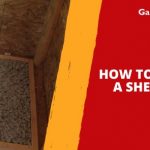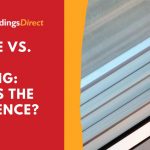Jump to:
We’ll cut to the chase. Yes, you’ll need air gap insulation to keep the interior temperature under control. It allows the exterior wall to breathe and prevents dampness and mould in shed.
Creating an air gap is straightforward, especially with the right guidelines in ‘sizing’. Here’s everything you need to know.
What Is ‘Air Gap’ and How It Works in Shed Insulation?

The air gap is present between the insulation material and the surface. It traps air in that space and acts as a buffer between the inside and outside temperatures. This, in turn, helps prevent heat loss or gain and keep moisture out.
Each centimetre of space air is equivalent to an additional layer of thermal barrier. This means that even a small air can improve the R-value. Overall, an air gap is an important element of effective insulation.
What Is the Minimum Air Gap Insulation?
You can’t simply leave a gap between your insulation and the surface and call it a day. This is where sizing comes in, and it varies depending on the material used and where it’s installed.
It’s recommended to leave an air gap insulation of at least 25mm or 1 inch for the walls and ceilings. This should be enough to allow for ventilation and prevent moisture buildup. The same rule may be applied when using foil insulation. On roofs, the air gap should be larger, typically around 50mm or 2 inches.
Note: Insulation materials like spray foam don’t require an air gap. They expand to fill all the nooks and crannies, creating a tight seal that seals air and moisture. For standard ones like fibreglass or mineral wood, follow the manufacturer’s guidelines. This will ensure that you’re installing the insulation correctly and safely.
Like most things, preparation is key when it comes to insulation. You need to make sure you have the right materials and that your shed is clean and dry before you start.
What’s in It for You as the Shed Owner?
The main benefit of air gap insulation is that it helps to stabilise the temperature inside your shed. This is especially useful in summer, as it’ll prevent the heat from building up and making it unbearable. Your belongings, such as wooden furniture, are protected from moisture damage.
Furthermore, it can help to reduce noise pollution from outside your shed. As a buffer zone, it absorbs and dampens sound waves before they can enter the building. This means less noise gets inside — ideal for workshop sheds.
How to Create an Air Gap?

There are a few different ways you can create an air gap insulation in your shed:
1. Baffles
One of the most popular methods is baffles. These are sheets of material that you install on the inside of your shed. They create an empty space between the insulation and the exterior. Plus, they ensure proper airflow and prevent any vents or openings from being blocked.
Material needed:
- Baffles
- Saw
- Screws or nails to affix
Installation instructions:
- Measure the inside of your shed so you know how many baffles (and of what size) you need.
- Cut the baffles to size, using a saw if necessary.
- Install the baffles on the inside of your shed, making sure they’re evenly spaced out. (You can use screws or nails to do this).
- Make sure there are no gaps between the baffles so that the air can flow freely.
2. Soffit vent
Another option is to install a soffit vent. This is a small opening in the shed that allows air to flow in and out. It should be properly sealed, as moisture could enter if it is not.
Materials needed:
- Soffit vent
- Caulking
- Screws
Installation instructions:
- Measure the opening for the soffit vent and cut it to size.
- Install the soffit vent in the opening, using caulking to seal it (and any gaps) in place.
3. Rigid foam
This type of insulation comes in sheets, which you can cut to size and fit in your shed. To prevent air from getting through, ensure that the foam is properly sealed. You can use caulking or tape to do this.
Materials needed:
- Rigid foam insulation
- Caulking or tape
Installation instructions:
- Cut the foam insulation to size so it fits snugly in your shed.
- Install the foam, using caulking or tape to seal any gaps.
- Double-check that there are no gaps or openings that air can get through.
If you have any further questions, contact us and don’t hesitate to give us a call at 01909 768840. Next on your reading list: How to Insulate a Garden Shed (A Mega Guide)










